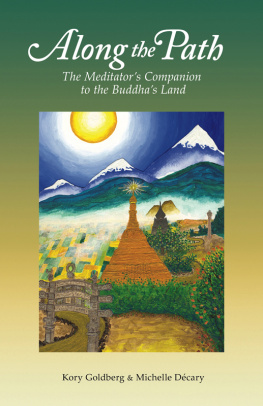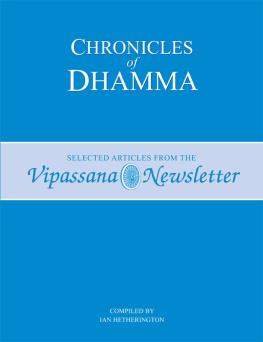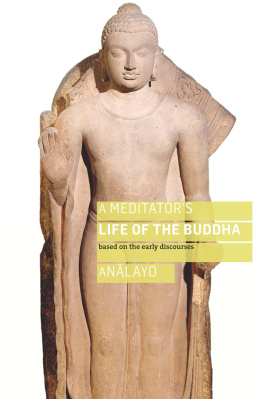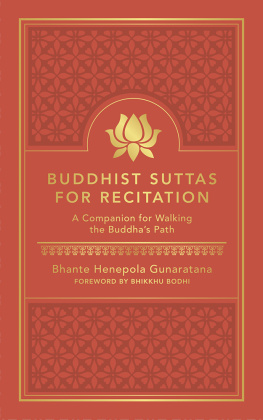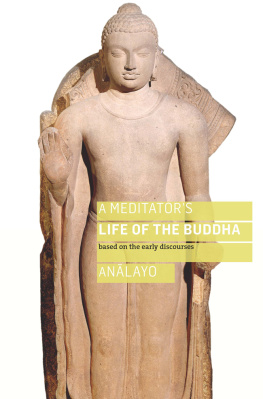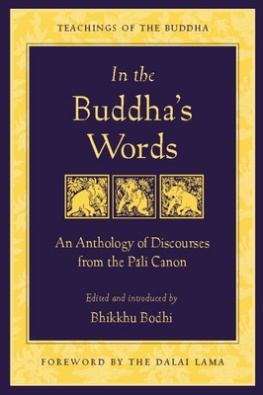
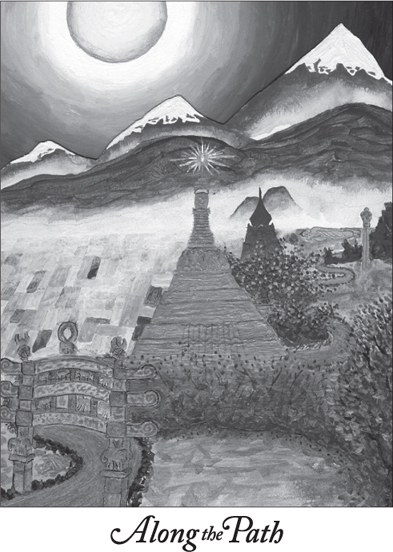
The Meditators Companion to the Buddhas Land
Kory Goldberg & Michelle Dcary

Kory Goldberg is a Humanities professor and Michelle Dcary is a freelance writer, yoga teacher and organic gardener. They have been practising Vipassana meditation and travelling to the Buddhas Land since the late 1990s.
Pariyatti Press
an imprint of Pariyatti Publishing
867 Larmon Road
Onalaska, WA 98570 USA
Tel. [+1] 360-978-4998
www.pariyatti.org
2012 by Kory Goldberg & Michelle Dcary
All rights reserved. No part of this book may be used or reproduced in any manner whatsoever without the written permission of the publisher, except in the case of brief quotations embodied in critical articles and reviews.
First Printing 2009
Second Printing 2012
ePub: 978-1-938754-03-6
Mobi: 978-1-938754-04-3
Library of Congress Control Number: 2009940411
Updates and resources: www.pilgrimage.pariyatti.org
The authors wish to thank Aleksei Gomez for permission to use his illustration on the cover and title page of this book. Thanks also goes to the following artists for the images they so readily offered for use in this publication:
- Llusot Domnech: pages 20, 22, 50, 70, 72, 117, 151 and 303.
- Anita Ghanekar: pages 79 and 282.
- Aleksei Gomez: also pages 100, 109, 132, 159, 241, 293 and 307.
- Gary Gronokowski: page xx.
- Nik the Bhik Halay: pages 111, 139 and 274.
- Jenny Jeffs: pages 1, 87, 89, 91, 108, 138, 157, 205, 234, 270 and 358.
- Michael Pancoe: pages 42, 66, 119, and 359.
- Godelive Richard: pages 3, 76, 77, 166, 305, 339 and 340.
- Bjarni Wark: pages 60, 81, 130, 169 and 175.
Printed in the United States of America
Not all who wander are lost.
J.R.R. Tolkien

Wherever you travel in this world,
Above, across, or below;
Carefully examine at all times
The arising and passing of all compounded things.
Gotama the Buddha
Pariyatti Press
Enriching the world by:
- Disseminating the words of the Buddha
- Providing sustenance for the seekers journey
- Illuminating the meditators path

Prologue
The sites throughout the Indian subcontinent associated with the life and teachings of the Buddha mark the locations of some of the most important events in the development of human consciousness. Since the time of the Buddha, pilgrims from all over the world have been inspired to overcome all sorts of difficult obstacles in order to meditate, pray and pay homage in these places. The pilgrims of old had to endure many hardships in their travels, such as crossing hot deserts, traversing rugged snow-covered mountains, or sailing stormy pirate-controlled waters, often suffering intense exposure to harsh climates and life-threatening illnesses. Todays modern pilgrims, like all travellers, are likely to face some struggles during a journey to these lands. Getting there is made much more comfortable, however, by our easy access to air-travel and an extensive network of trains, mobile phones and high-speed internet, savvy travel agents and a wide range of guide books. Nevertheless, these luxuries do not lessen the benefits of pilgrimage (yatra), nor do they necessarily diminish the evocative impressions many discover when visiting the sites and learning about what took place at each one. Experiencing these places firsthand, and feeling their continued spiritual vibrancy amidst the surrounding bustle of modern life, provides an entirely fresh dimension to any meditators understanding of the Buddha, Dhamma and Sagha.
Visiting these places also enables us to appreciate the historical, social and artistic dimensions of the Buddhas life and teaching, which is difficult to comprehend while remaining at home. Witnessing the legacy of commemorative monuments, modern temples, monasteries and impressive artistic worksall bequeathed to the world by international adepts of the Dhammahas the capacity to increase our awe of the Dhammas magnitude, and to strengthen our own confidence in the practice of the Path.
The aim of this book is to assist the traveller, on different levels, along the pilgrims route. In retelling the events of the Buddhas life, we have attempted to maintain the liveliness of the Pli canon stories without compromising their meaning, theme and authenticity. We have revised the difficult and archaic language of direct translation, making the stories more readable for pilgrims, especially for those who are not native English speakers.
With regard to travelling we give pointers and tips to help meditators reach the sacred places with fewer hassles; however, nothing is guaranteed. Everything in life is uncertain, and even more so in topsy-turvy India, where things are always changing with great rapidity: names, numbers, addresses, bus/train schedules and all else in between. To prevent the book from being inaccurate or becoming tooquickly dated, we try to provide general, open-ended information in order to help free travellers from attachment to assurance in a land where nothing can be assured. This, in fact, is one of the benefits of pilgrimage in the Indian subcontinent.
We also want travellers to discover the Buddhas modern India for themselves, rather than follow a pre-scripted step-by-step tourists track. Experience is obviously the best guide, and therefore the goal of this book is not to provide technical, archaeological, historical or economical details of these places (other books have already done a very good job of this), but to help enable the pilgrim to understand why these are important places to visit and in which to meditate. We hope that in this way, the mindful and receptive meditator can gain a deeper sense of the Buddhas teachings in the places where they were first given, and can reflectively visualize what life must have been like almost 2 600 years ago. These reflections, rooted in insight, can produce delightful and mature fruits of understanding. Rather than behaving like the average tourist sight-seer, who merely looks around and takes some snaps of Indias historical skeletonthe ruins, the temples, the palaces, the Himlayawe encourage the traveller to meditate in these places, becoming a site-sitter who feels the living energy of these tremendous sites for themselves.
The Buddhas teachings have only recently returned to India, and it is our belief that travellers who meditate are best equipped to contact the rich spiritual tradition of the Dhamma that lies at Indias heart. Moreover, while travelling in these lands, meditators have the unique opportunity to not only grow in Dhamma themselves, but also to help the Dhamma flourish again in the land of its origin.
Wherever we are, whether in India or at home, we are encouraged by the Buddhas teachings to try and actualize, in our everyday lives, five requisites for practising the path of meditative awareness: proper devotion, good health, honesty, diligence and wisdom.
To begin with, we feel that its important while on pilgrimage to consciously cultivate
Next page
